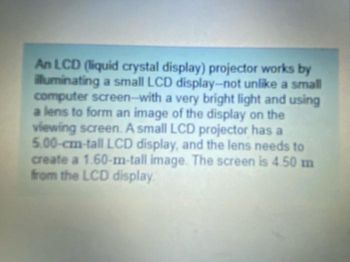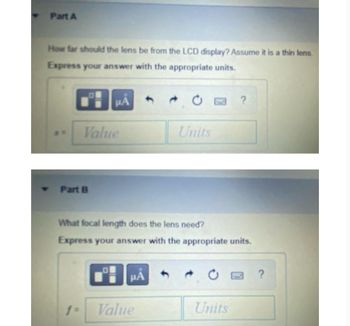Question

Transcribed Image Text:An LCD (liquid crystal display) projector works by
illuminating a small LCD display-not unlike a small
computer screen-with a very bright light and using
a lens to form an image of the display on the
viewing screen. A small LCD projector has a
5.00-cm-tall LCD display, and the lens needs to
create a 1.60-m-tall image. The screen is 4.50 m
from the LCD display

Transcribed Image Text:Part A
How far should the lens be from the LCD display? Assume it is a thin lens.
Express your answer with the appropriate units.
Part B
103
f=
PA
Value
What focal length does the lens need?
Express your answer with the appropriate units.
μA
Units
Value
?
Units
Expert Solution
This question has been solved!
Explore an expertly crafted, step-by-step solution for a thorough understanding of key concepts.
Step by stepSolved in 2 steps with 2 images

Knowledge Booster
Similar questions
- A lens system consists of a +4D lens and a +3D lens separated by 10 cm. Find the equivalent focal power and the positions of the principal points. An object 3 cm long is situated 50 cm in front of the first lens. What will be the position and size of the image produced by the combination?arrow_forwardAn object is located at 2 cm from the lens with optical power of 10 D. What is the distance between the lens and the image? Draw the ray tracing, the image and characterize it.arrow_forwardA 4.0-cm-diameter flower is 200 cm from the 50-cm-focal-length lens of a camera. How far should the plane of the camera’s light detector be placed behind the lens to record a well-focused image? What is the diameter of the image on the detector?arrow_forward
- An inquiring student makes a refracting telescope by placing an objective lens and an eyepiece at opposite ends of a 46.5 cm long tube. If the eyepiece has a focal length of 1.70 cm, calculate the required focal length in cm of the objective lens and the angular magnification of the telescope. HINT (a) the required focal length in cm of the objective lens cm (b) the angular magnification of the telescopearrow_forwardA slide projector needs to create a 96-cm-high image of a 2.0-cm-tall slide. The screen is 310 cm from the slide. part a) What focal length does the lens need? Assume that it is a thin lens. part b) How far should you place the lens from the slide?arrow_forwardCreate a ray diagram for eyeglasses that contain a diverging lens. Assume you are looking at a 2 cm tall object that is 4 cm from the lens. The focal length is 3 cm. What type of vision are they used to correct? Give both names. How do they do this? Explain.arrow_forward
- Problem 8: The objective lens of the refracting telescope at the Lick Observatory in California has a focal length of 57 ft. a. What is the refractive power of this lens? b. What focal length (mm) eyepiece would give a magnification of 1000X for this telescope?arrow_forwardA lens of focal length 42 mm is used as a magnifier. The object being viewed is 6.8 mm long, and is positioned at the focal point of the lens. The lens is moved closer to the object, so that the image is now 15 cm from the lens. The distance the lens has been moved, in cm, is closest to:arrow_forwardAn object located 32 cm in front of a lens forms an image on a screen 8 cm behind the lens. a) Find the focal length of the lens. What type of lens is it? b) What is the magnification of the object?arrow_forward
- (numbers 8-9) An object is placed 12 cm from a diverging lens with a focal length of -6 cm. 8. How far is the image from the lens? 4 cm 4.5 cm 6 cm 8 cm 12 cm 9. The image is: real and smaller real and larger virtual and smaller virtual and larger none of the above answers are correctarrow_forwardTo fit a contact lens to a patient's eye, a keratometer can be used to measure the curvature of the cornea-the front surface of the eye. This instrument places an illuminated object of known size at a known distance p from the cornea, which then reflects some light from the object, forming an image of it. The magnification M of the image is measured by using a small viewing telescope that allows a comparison of the image formed by the cornea with a second calibrated image projected into the field of view by a prism arrangement. Determine the radius of curvature of the cornea whenp = 28.0 cm and M = 0.0140.arrow_forward
arrow_back_ios
arrow_forward_ios